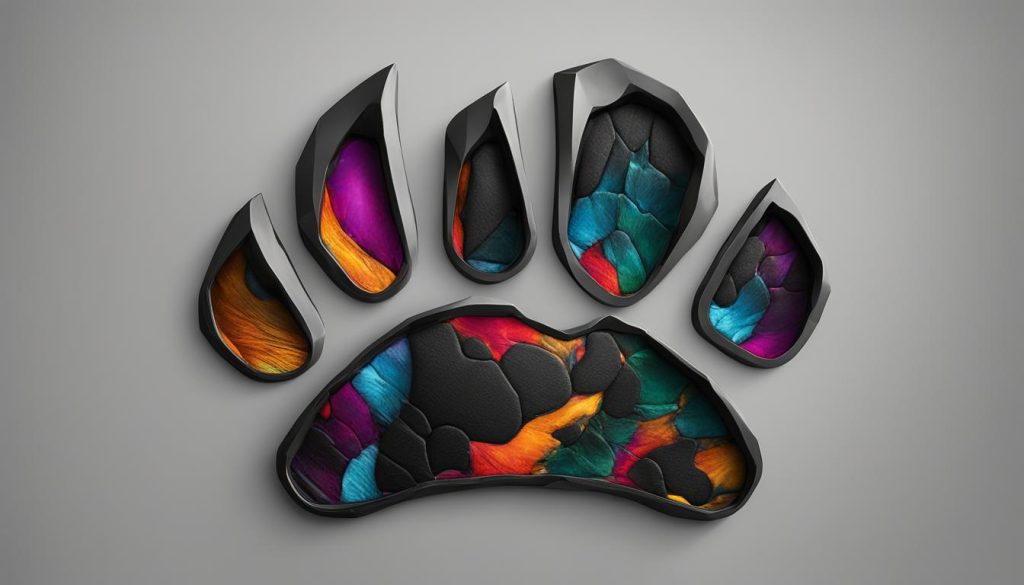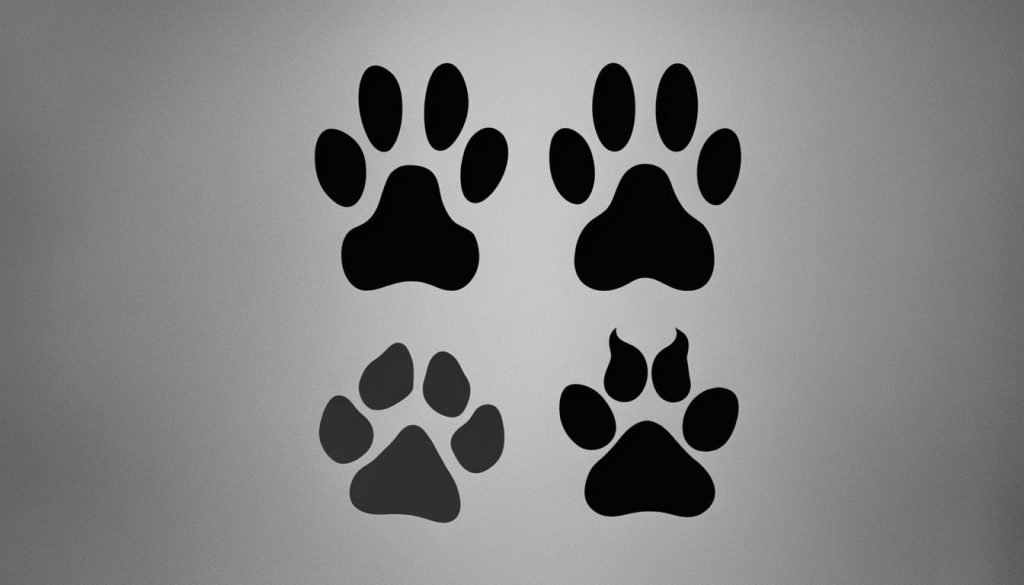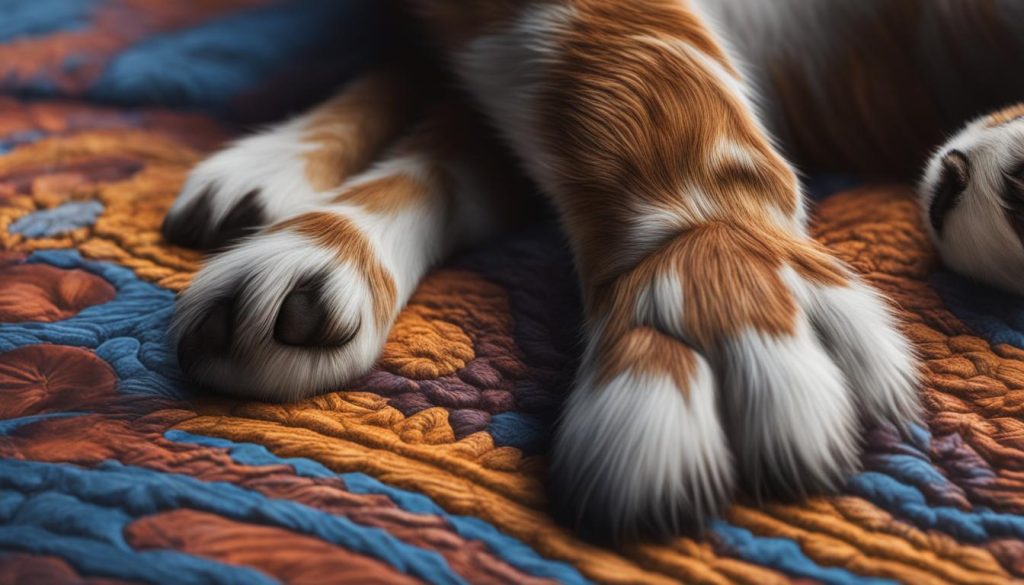Cats and dogs have unique paw characteristics that set them apart. While they share some similarities, there are key differences between cat paws and dog paws. In this article, I will explore the anatomy, shape, function, and claws of cat and dog paws to understand their distinct features.
Key Takeaways:
- Cat paws and dog paws have distinct differences in size, shape, and anatomy.
- Cat paws have a circular shape with tear-drop-shaped pads, while dog paws have an oval shape.
- Cat paw pads act as a cushion and shock absorber, while dog paw pads provide traction for activities like running and digging.
- Cat claws are retractable and used for climbing, hunting, and self-defense, while dog claws are non-retractable and provide stability and grip.
- The paw prints of cats and dogs have different shapes and symmetries.
Overview of Cat Paws
Cat paws are fascinating and unique, with distinct features that contribute to their agile and nimble nature. Let’s take a closer look at the anatomy, shape, and uses of cat paws.
Anatomy
The paws of cats are designed for flexibility and precision. They consist of five toes on the front paws and four toes on the hind paws. Each toe is equipped with a sharp and retractable claw, which serves various purposes such as climbing, grooming, and hunting.
Shape and Pads
Cat paws have a circular shape, which helps them navigate different surfaces with ease. The tear-drop-shaped pads provide stability and control, allowing cats to maintain their balance even on uneven or slippery terrain. These pads also act as shock absorbers, cushioning their steps while walking or jumping.

Uses
Cats utilize their paws for a myriad of activities. Their flexible toes and sharp claws enable them to climb trees, catch prey, and defend themselves when necessary. Additionally, cats have a remarkable grooming ability, and their paws play a crucial role in keeping their fur clean and tangle-free.
Table: Comparison of Cat Paw Pads and Dog Paw Pads
| Cat Paw Pads | Dog Paw Pads | |
|---|---|---|
| Shape | Circular | Oval |
| Number of Pads | Five on front paws, four on hind paws | Seven on front paws, five on hind paws |
| Texture | Soft | Rough |
| Function | Cushioning and grip | Traction and stability |
As we can see, cat paws have unique characteristics that allow them to perform their agile and precise movements effectively. Their circular shape, tear-drop pads, and retractable claws all contribute to their impressive climbing, hunting, and grooming abilities.
Stay tuned for the next section, where we will explore the fascinating features of dog paws and compare them to cat paws.
Overview of Dog Paws
When it comes to dog paws, their anatomy, shape, and pads differ from those of cats. Dog paws have an oval shape, which provides them with stability and balance while standing or walking on various terrains. They have seven pads on their front paws and five pads on their hind paws, offering them extra cushioning and protection.
Dog paw pads play a crucial role in maintaining traction and providing stability during activities like running, walking, and even digging. Unlike cats, dogs are not as agile, but their paws are designed for endurance-based tasks. The rough texture of their paw pads allows them to withstand the wear and tear of outdoor activities while ensuring a secure grip.
In addition, dog claws are always exposed and non-retractable. These claws are thicker and stronger than those of cats, but they are not as sharp. Dogs utilize their claws for weight-bearing and to enhance their grip while running or walking on different surfaces.
Table: Comparison of Cat Paws and Dog Paws
| Cat Paws | Dog Paws | |
|---|---|---|
| Paw Shape | Circular | Oval |
| Number of Pads (Front Paw) | 5 | 7 |
| Number of Pads (Hind Paw) | 4 | 5 |
| Paw Pad Texture | Soft | Rough |
| Claw Retractability | Retractable | Non-retractable |
As illustrated in the table above, there are clear differences in the shape, number of pads, paw pad texture, and claw retractability between cat paws and dog paws. These distinctions contribute to the unique abilities and functions of each animal’s paws, highlighting the remarkable adaptations found in the animal kingdom.
Claw Differences
One of the significant differences between cat and dog paws lies in their claws. Cat claws are retractable, meaning they can be extended or retracted into a protective sheath. This unique feature allows cats to keep their claws sharp and use them for various purposes such as climbing, hunting, and self-defense. On the other hand, dog claws are non-retractable and always exposed, serving a different set of functions.
Dog claws are thicker and stronger compared to cat claws. While they may not be as sharp, they are designed to provide dogs with traction and stability during activities like running or digging. The non-retractable nature of dog claws allows for continuous weight-bearing and effective grip on different surfaces. Although both cat and dog claws serve their respective needs, the retractability of cat claws gives them an added advantage in certain situations.
To summarize, cat claws are retractable, allowing for sharpness and versatility in various tasks, while dog claws are non-retractable, offering strength, traction, and stability. This distinction in claw characteristics showcases how cats and dogs have evolved to meet their unique needs and behaviors.
| Cat Claws | Dog Claws | |
|---|---|---|
| Retractability | Retractable | Non-retractable |
| Sharpness | Sharp | Not as sharp |
| Function | Climbing, hunting, self-defense | Traction, stability |
Shape and Paw Pads
Cat paws have a distinct circular shape, which contributes to their remarkable climbing and gripping abilities. The circular shape allows cats to evenly distribute their weight, providing stability on uneven surfaces and enhancing their balance. The tear-drop-shaped paw pads on cat paws play a crucial role in their agility. These pads act as shock absorbers, cushioning each step and allowing cats to navigate various terrains with ease.
In contrast, dog paws have an oval shape, which gives them stability and balance while standing on the ground. The elongated shape provides a larger surface area for weight distribution, making dog paws well-suited for endurance-based activities like running and digging. The paw pads on dog paws are rougher in texture compared to cat paw pads. This roughness helps dogs maintain traction while walking or running, preventing slips and enhancing their grip.
Both cat and dog paw pads are essential for their overall well-being. They protect the bones and joints from the impact of walking and jumping, reduce strain on their muscles, and provide insulation from extreme temperatures. While cat paw pads are softer to the touch, dog paw pads are tougher and more durable, reflecting the different needs and lifestyles of these animals.

Paw Shape Comparison
| Cat Paws | Dog Paws | |
|---|---|---|
| Shape | Circular | Oval |
| Main Function | Agility and Climbing | Endurance and Stability |
| Paw Pads | Tear-drop shaped | Rough-textured |
| Retractable Claws | Yes | No |
“The circular shape of cat paws and the oval shape of dog paws reflect their distinctive abilities and lifestyles.”
Understanding the shape and characteristics of cat and dog paws gives us insight into the natural behaviors and adaptations of these animals. Whether it’s the circular shape and tear-drop-shaped paw pads of cat paws for exceptional climbing and gripping, or the oval shape and rough-textured paw pads of dog paws for endurance and traction, each feature serves a specific purpose in their respective lives. The shape and paw pads of cat and dog paws truly demonstrate the remarkable diversity seen in the animal kingdom and further emphasize the unique nature of these beloved pets.
Lobes on the Plantar Pads
When examining the plantar pads of cat and dog paws, we can observe some interesting differences. Cats have a unique asymmetrical arrangement of lobes on their plantar pads. The large heel pad of a cat’s paw consists of two lobes at the front and three lobes at the rear. This unique configuration is reflected in a cat’s paw print, making it easily distinguishable from a dog’s paw print. On the other hand, dogs have a symmetrical arrangement of lobes on their plantar pads. Their paw print showcases a single lobe at the front and two lobes at the rear, creating a balanced and symmetrical pattern.
This distinction in lobe arrangement not only contributes to the visual differences in paw prints, but it also affects the way cats and dogs distribute weight and apply pressure while walking. The asymmetrical lobes on a cat’s plantar pad provide them with enhanced stability and maneuverability during climbing and jumping activities. In contrast, the symmetrical lobes on a dog’s plantar pad offer them a balanced stride, aiding in their endurance-based activities like running and walking. These unique lobe configurations play a significant role in shaping the characteristics and behaviors of our feline and canine companions.
To further understand the differences in the plantar pads and their lobes, let’s take a closer look at the comparative table below:
| Cat Paw | Dog Paw | |
|---|---|---|
| Plantar Pad Lobes | Two lobes at the front, Three lobes at the rear | One lobe at the front, Two lobes at the rear |
| Paw Print Symmetry | Asymmetrical | Symmetrical |
As we can see from the table, the lobes on the plantar pads significantly differ between cat and dog paws. These variations in lobe arrangement contribute to the unique paw prints and functional abilities of our feline and canine friends. Understanding these distinctions allows us to appreciate the intricate design and adaptations that make cats and dogs such fascinating creatures.

| Cat Paw Print | Dog Paw Print | |
|---|---|---|
| Paw Shape | Asymmetric | Symmetrical |
| Number of Pads | Five pads on front paws Four pads on hind paws |
Seven pads on front paws Five pads on hind paws |
| Toe Arrangement | Two lobes at front Three lobes at rear |
Single lobe at front Two lobes at rear |
Skin Texture
When comparing the skin texture of cat and dog paw pads, there are noticeable differences. Cat paw pads have a soft texture, providing a cushioned feel and protecting their paws while walking and jumping. This softness allows cats to move silently and with precision, making them excellent hunters. The delicate skin on their paw pads also enables them to navigate various surfaces, including branches, furniture, and even fences, with ease.
Dog paw pads, on the other hand, have a tougher and more durable texture. The thick skin acts as a protective barrier, especially for dogs engaging in activities like running, digging, and exploring rough terrains. Dogs rely on the toughness of their paw pads to withstand more intense physical activities and resist abrasion.
However, it is essential to note that if a dog’s paw pads appear shredded or damaged, it may indicate an underlying medical condition that requires attention. In such cases, it is advisable to consult a veterinarian who can provide proper diagnosis and treatment.
The Importance of Paw Pad Care
Regardless of whether you have a cat or a dog, it is crucial to pay attention to the condition of their paw pads. Regularly inspecting them for any signs of cuts, cracks, or abnormalities will help you identify potential issues early on. Additionally, keeping your pet’s paw pads clean and moisturized can help maintain their overall skin health.
“Proper paw pad care not only contributes to your pet’s comfort but also prevents potential injuries or infections. It’s important to keep their paw pads in optimal condition to support their mobility and well-being.” – Dr. Emily Brown, Veterinarian
In conclusion, the skin texture of cat and dog paw pads differs significantly. While cat paw pads are soft and delicately cushioned, dog paw pads are tougher and more resilient. Understanding these differences can help pet owners provide the appropriate care and attention to their furry companions’ paws.
| Paw Pad Texture | Characteristics |
|---|---|
| Cat | Soft and cushioned |
| Dog | Tough and resilient |

Wrapping Up
In conclusion, when comparing cat paws and dog paws, it is evident that they have key differences and similarities. Cat paws are designed for agility, climbing, and hunting, while dog paws are built for endurance and stability. These differences in function result in contrasting shapes and anatomical features.
One of the significant differences lies in the retractability of claws. Cats have retractable claws, allowing them to keep their claws sharp and use them for various purposes. Dogs, on the other hand, have non-retractable claws that provide stability and traction during activities.
Shape and paw pads also vary between the two. Cat paws have a circular shape with tear-drop-shaped pads, aiding in climbing and gripping surfaces. Dog paws, with their oval shape, provide balance while standing on the ground. Both cat and dog paw pads act as cushions and provide traction, but cat paw pads are softer to the touch.
While there are differences, it is also important to note the similarities between cat paws and dog paws. They both have paw pads that serve as shock absorbers and protect the animal’s bones and joints. Additionally, both cats and dogs rely on their paws for essential activities such as walking and running.
FAQ
What are the key differences between cat paws and dog paws?
Cat paws have a circular shape with tear-drop-shaped pads, while dog paws have an oval shape. Cat paws have retractable claws, while dog claws are always exposed. Cat paws are designed for agility and climbing, while dog paws are built for endurance and stability.
How many pads do cat paws and dog paws have?
Cat paws have five pads on their front paws and four pads on their hind paws. Dog paws have seven pads on their front paws and five pads on their hind paws.
What are the functions of cat paws and dog paws?
Cat paws are used for climbing, gripping, grooming, and hunting. Dog paws are used for endurance-based activities like running and digging.
Are cat claws retractable?
Yes, cat claws are retractable. They can be extended or retracted into a protective sheath.
Are dog claws retractable?
No, dog claws are not retractable. They are always exposed.
What is the shape of cat paw pads?
Cat paw pads have a circular shape.
What is the shape of dog paw pads?
Dog paw pads have an oval shape.
Are cat paw pads soft?
Yes, cat paw pads have soft skin, providing a cushioned feel while walking and jumping.
Are dog paw pads rough?
Yes, dog paw pads are rougher than cat paw pads and provide traction for activities like running and digging.
Are cat paw prints symmetrical or asymmetrical?
Cat paw prints are asymmetrical, with the left and right sides of the print not being the same.
Are dog paw prints symmetrical or asymmetrical?
Dog paw prints are symmetrical, with the left and right sides mirroring each other.
What should I do if my dog’s paw pads appear shredded?
If your dog’s paw pads appear shredded, it may indicate an underlying medical condition. It is recommended to have them checked by a veterinarian.






